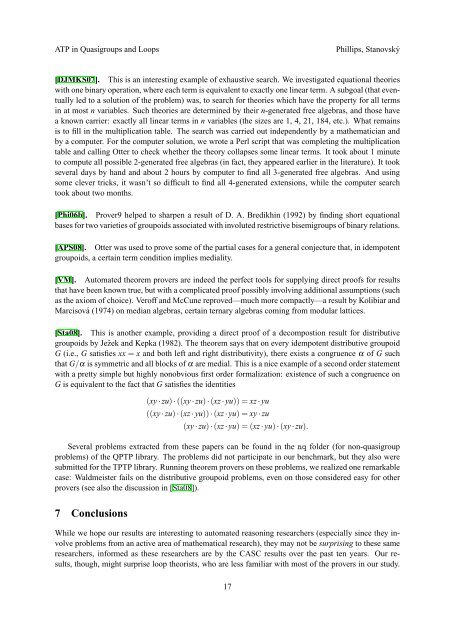Automated Theorem Proving in Quasigroup and Loop Theory
Automated Theorem Proving in Quasigroup and Loop Theory
Automated Theorem Proving in Quasigroup and Loop Theory
Create successful ePaper yourself
Turn your PDF publications into a flip-book with our unique Google optimized e-Paper software.
ATP <strong>in</strong> <strong>Quasigroup</strong>s <strong>and</strong> <strong>Loop</strong>s<br />
Phillips, Stanovský<br />
[DJMKS07]. This is an <strong>in</strong>terest<strong>in</strong>g example of exhaustive search. We <strong>in</strong>vestigated equational theories<br />
with one b<strong>in</strong>ary operation, where each term is equivalent to exactly one l<strong>in</strong>ear term. A subgoal (that eventually<br />
led to a solution of the problem) was, to search for theories which have the property for all terms<br />
<strong>in</strong> at most n variables. Such theories are determ<strong>in</strong>ed by their n-generated free algebras, <strong>and</strong> those have<br />
a known carrier: exactly all l<strong>in</strong>ear terms <strong>in</strong> n variables (the sizes are 1, 4, 21, 184, etc.). What rema<strong>in</strong>s<br />
is to fill <strong>in</strong> the multiplication table. The search was carried out <strong>in</strong>dependently by a mathematician <strong>and</strong><br />
by a computer. For the computer solution, we wrote a Perl script that was complet<strong>in</strong>g the multiplication<br />
table <strong>and</strong> call<strong>in</strong>g Otter to check whether the theory collapses some l<strong>in</strong>ear terms. It took about 1 m<strong>in</strong>ute<br />
to compute all possible 2-generated free algebras (<strong>in</strong> fact, they appeared earlier <strong>in</strong> the literature). It took<br />
several days by h<strong>and</strong> <strong>and</strong> about 2 hours by computer to f<strong>in</strong>d all 3-generated free algebras. And us<strong>in</strong>g<br />
some clever tricks, it wasn’t so difficult to f<strong>in</strong>d all 4-generated extensions, while the computer search<br />
took about two months.<br />
[Phi06b]. Prover9 helped to sharpen a result of D. A. Bredikh<strong>in</strong> (1992) by f<strong>in</strong>d<strong>in</strong>g short equational<br />
bases for two varieties of groupoids associated with <strong>in</strong>voluted restrictive bisemigroups of b<strong>in</strong>ary relations.<br />
[APS08]. Otter was used to prove some of the partial cases for a general conjecture that, <strong>in</strong> idempotent<br />
groupoids, a certa<strong>in</strong> term condition implies mediality.<br />
[VM]. <strong>Automated</strong> theorem provers are <strong>in</strong>deed the perfect tools for supply<strong>in</strong>g direct proofs for results<br />
that have been known true, but with a complicated proof possibly <strong>in</strong>volv<strong>in</strong>g additional assumptions (such<br />
as the axiom of choice). Veroff <strong>and</strong> McCune reproved—much more compactly—a result by Kolibiar <strong>and</strong><br />
Marcisová (1974) on median algebras, certa<strong>in</strong> ternary algebras com<strong>in</strong>g from modular lattices.<br />
[Sta08]. This is another example, provid<strong>in</strong>g a direct proof of a decompostion result for distributive<br />
groupoids by Ježek <strong>and</strong> Kepka (1982). The theorem says that on every idempotent distributive groupoid<br />
G (i.e., G satisfies xx = x <strong>and</strong> both left <strong>and</strong> right distributivity), there exists a congruence α of G such<br />
that G/α is symmetric <strong>and</strong> all blocks of α are medial. This is a nice example of a second order statement<br />
with a pretty simple but highly nonobvious first order formalization: existence of such a congruence on<br />
G is equivalent to the fact that G satisfies the identities<br />
(xy · zu) · ((xy · zu) · (xz · yu)) = xz · yu<br />
((xy · zu) · (xz · yu)) · (xz · yu) = xy · zu<br />
(xy · zu) · (xz · yu) = (xz · yu) · (xy · zu).<br />
Several problems extracted from these papers can be found <strong>in</strong> the nq folder (for non-quasigroup<br />
problems) of the QPTP library. The problems did not participate <strong>in</strong> our benchmark, but they also were<br />
submitted for the TPTP library. Runn<strong>in</strong>g theorem provers on these problems, we realized one remarkable<br />
case: Waldmeister fails on the distributive groupoid problems, even on those considered easy for other<br />
provers (see also the discussion <strong>in</strong> [Sta08]).<br />
7 Conclusions<br />
While we hope our results are <strong>in</strong>terest<strong>in</strong>g to automated reason<strong>in</strong>g researchers (especially s<strong>in</strong>ce they <strong>in</strong>volve<br />
problems from an active area of mathematical research), they may not be surpris<strong>in</strong>g to these same<br />
researchers, <strong>in</strong>formed as these researchers are by the CASC results over the past ten years. Our results,<br />
though, might surprise loop theorists, who are less familiar with most of the provers <strong>in</strong> our study.<br />
17
















